Cucurbitaceous Vegetable Diseases
Cucurbitaceous Vegetable Diseases
Downy mildew
Host range
- Musk melon, Sponge gourd and Bitter gourd etc.
Symptoms:
- Yellow, angular spots restricted by veins resembling mosaic mottling appear on upper surface of leaves
- The corresponding lower surface of these spots shows a purplish downy growth in moist weather
- The spots turn necrotic with age
- The diseased leaves become yellow and fall down
- Diseased plants get stunted and die
- Fruits produced may not mature and have a poor taste
Survival and spread:
- Primary: Oospores in soil and sporangia from perennial collateral weed hosts in the vicinity
- Secondary: Wind borne and rain splashed conidia (sporangia) or autonomous zoospores
Favourable conditions:
- Relative humidity > 90%
- High soil moisture
- Frequent rains
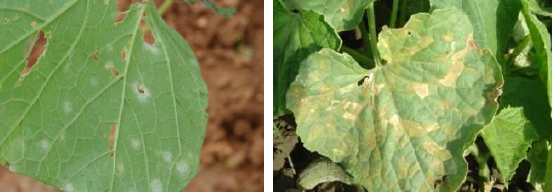
Powdery mildew
Host range:
- Pumpkins, bottle gourd, coccinia, cucumber, ridge gourd, Bitter gourd is less affected.
Symptoms:
- Whitish or dirty grey, powdery growth on foliage, stems and young growing parts
- The superficial growth ultimately covers the entire leaf area
- The diseased areas turn brown and dry leading to premature defoliation and death
- Fruits remain underdeveloped and are deformed
Survival and spread:
- Primary: Dormant mycelium or cleistothecia in infected plant debris or conidia from collateral hosts
- Secondary: Wind borne conidia
Favourable conditions:
- Morning relative humidity > 90%
- Cool and dry weather
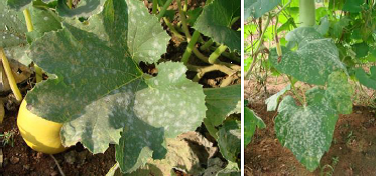
Cucumber mosaic
Wide host range:
- Cucumber, Pumpkin, gourds, Cowpea, tomato, chilli, etc. Cucumovirus with spherical particles having ssRNA
Symptoms:
- Symptoms appear on the youngest and still expanding leaves when infection occurs at 6 – 8 leaves stage
- Typical mosaic pattern develops on young leaves
- Leaves curl downwards and become mottled, distorted, wrinkled and reduced in size
- Veins appear bunchy because of shortening of internodes
- When infection occurs at midseason previous growth remains normal and produces normal fruit
- Fruit set is very less if infection occurs early in crop growth
- Fruits are often misshapen, mottled, warty and reduced in size
Survival and spread:
- Primary: Virus particles on collateral and other weeds, ornamentals or crops Hosts: Banana, clover, corn, passion fruit, safflower, spinach, sugarbeet, wild cucumber, Commelina communis, C. diffusa, C. nudiflora, Solanum elaegnifolium, Phytolacca sp., periwinkle, Gladiolus sp., Impatiens sp. and Phlox
- Secondary: Virus particles transmitted by aphids (Aphis craccivora, Myzus persicae) and spotted and striped cucumber beetles
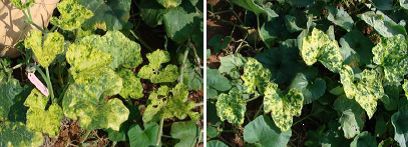
Cercospora leaf spot
Host range:
- Common on watermelon, muskmelon and cucumber
Symptoms:
- Minute water soaked spots or yellow specks develop initially on leaves
- Spots enlarge rapidly and
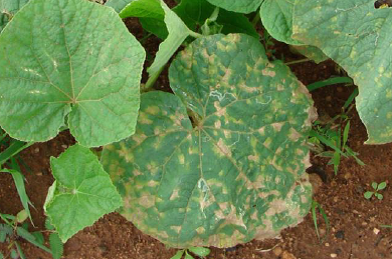 becomes circular to irregular with pale brown, tan or white centers and purple to almost black margins
becomes circular to irregular with pale brown, tan or white centers and purple to almost black margins - Spots coalesce to form large blotches
- The leaf may dry and die presenting the leaf a scorched appearance
- Fruits are also occasionally attacked
Survival and spread:
- Primary: Dormant mycelium or conidia on infected plant debris or collateral hosts
- Secondary: Wind borne conidia
Fusarium wilt
Damage symptoms:
- The first symptom of the disease is clearing of the veinlets and
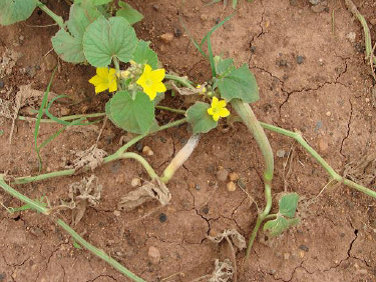 chlorosis of the leaves.
chlorosis of the leaves. - The younger leaves may die in succession and the entire may wilt and die in a course of few days.
- Soon the petiole and the leaves droop and wilt.
- In young trailing plant, symptom consists of clearing of veinlet and dropping of petioles. In field, yellowing of the lower leaves first and affected leaflets wilt and die.
- The symptoms continue in subsequent leaves. At later stage, browning of vascular system occurs. Plants become stunted and die.
Survival and spread:
- Soil and implements
Favourable conditions:
- Relatively high soil moisture and soil temperature
Diseases cycles
Downy mildew: Pseudoperonospora cubensis
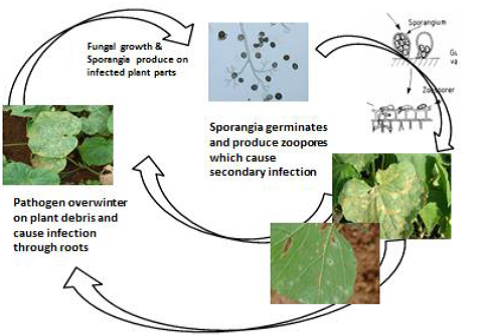
Powdery mildew: Erysiphe cichoracearum DC, Sphaerotheca fuligena (Schltdl.) Pollacci
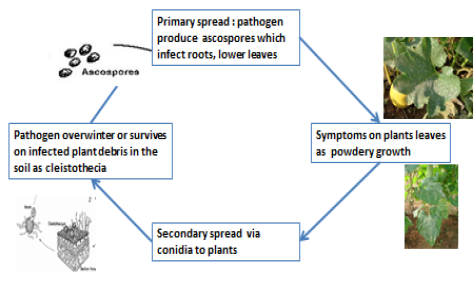
Cercospora leaf spot: Cercospora leaf spot C. citrullina, C. melonis, C. lagenarium
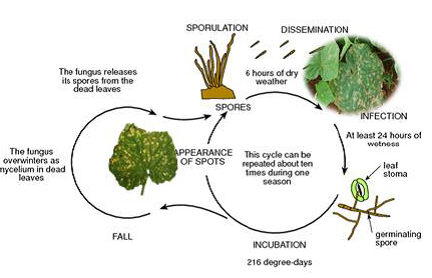
Fusarium wilt: Fusarium oxysporum Schlecht
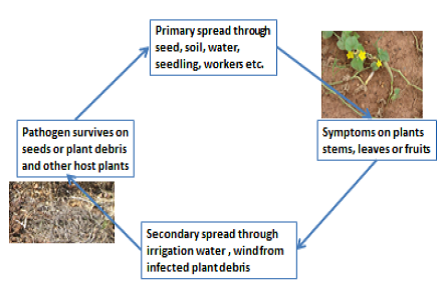
IPM for Cucurbitaceous Vegetable
To know the IPM practices for Cucurbitaceous Vegetable, click here
Source: NIPHM, Directorate of Plant Protection, Quarantine & Storage
Last Modified : 3/23/2020
This topic covers the Information related to Disea...
This topic provides information about Apricot-Desc...
This topic explains about Improved Cultivation Pra...
This topic covers information about Ber Diseases.
